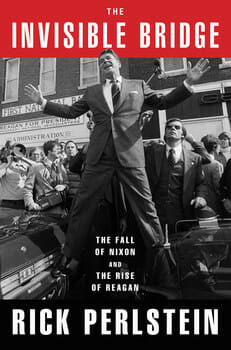Rick Perlstein on America’s Nervous Breakdown


This past weekend brought bright and starry reviews for Baffler contributing editor Rick Perlstein’s new book about the tumultuous 1970s, The Invisible Bridge: The Fall of Nixon and the Rise of Reagan, out now.
Max Boot in the Wall Street Journal admires how Perlstein—while remaining “one of our foremost chroniclers of the rise of the modern conservative movement”—saves his strongest ire for “clueless establishment liberals.” The Boston Review’s Mark Schmitt uses the word “brilliant” more than once. Frank Rich in the New York Times calls Perlstein an “obsessive researcher” and compares his three–volume project to the work of Robert Caro. Not too shabby, Rick.
By all means, go get yourself a copy. But while you’re on your way to the bookstore, get up to speed by reading two of his salvos from The Baffler that helped him develop his ideas for the book. (Look up while you’re walking and reading, though, please—we can’t be liable if you walk into a telephone pole.)
For issue 19 in 2012, he wrote about the path from Nixon to Reagan in “Ronald Reagan’s Imaginary Bridges.” This piece introduced the advice from Nikita Khrushchev to Richard Nixon that gave Perlstein’s larger project its name: “If the people believe there’s an imaginary river out there, you don’t tell them there’s no river there. You build an imaginary bridge over the imaginary river.” (“Ronald Reagan built bridges like that,” Perlstein wrote.) Here’s an excerpt, in which he describes the aftermath of the Vietnam War:
When the prisoners of war returned, the White House and the Pentagon tried to orchestrate a good old-fashioned unifying ritual of patriotic renewal. Richard Nixon, speaking in the Oval Office to the Pentagon official in charge of what was christened “Operation Homecoming,” said, “It’s like a producer putting on a great play or a great movie. You have a hell of a bunch of stars in this one. It’s an all-star cast—even the bit players.” The Boston Brahmin Elliot Richardson, Nixon’s secretary of defense, put it more soberly: “The returning POWs have dramatically launched what DOD is trying to do to restore the military to its proper position.” Nixon summed up: “We now have an invaluable opportunity to revise the history of this war.”
Later that year, for issue 21, Perlstein again examined how politically conservative causes have historically used patriotic propaganda to further their goals—not just in the media, duh, but through direct mail campaigns. As a subscriber to Townhall and Newsmax, he got served with some pretty weird ads. And he found that it was hard to tell “where the ideological con ended and the money con began.” Here’s an excerpt of that piece, called “The Long Con”:
Those tactics gelled in the seventies—though they were rooted, like all things right-wing and infrastructural, in the movement that led to Barry Goldwater’s presidential nomination in 1964. In 1961 Richard Viguerie, a kid from Houston whose heroes, he once told me, were “the two Macs”—Joe McCarthy and General Douglas MacArthur—took a job as executive director for the conservative student group Young Americans for Freedom (YAF). The organization was itself something of a con, a front for the ideological ambitions of the grownups running National Review. And fittingly enough, the middle-aged man who ran the operation, Marvin Liebman, was something of a P. T. Barnum figure, famous on the right for selling the claim that he had amassed no less than a million signatures on petitions opposing the People’s Republic of China’s entry into the United Nations. (He said they were in a warehouse in New Jersey. No one ever saw the warehouse.) The first thing Liebman told Viguerie was that YAF had two thousand paid members but that in public, he should always claim there were twenty-five thousand. (Viguerie told me this personally. I found no evidence he saw anything to be ashamed of.) And the first thing that Liebman showed Viguerie was the automated “Robotype” machine he used to send out automated fundraising pitches. Viguerie’s eyes widened; he had found his life’s calling.
Unrelated fun fact: Rick Perlstein’s first piece for The Baffler (in issue 3, 1992) was an in-depth analysis of Scooby Doo. He’s come a long way since then. But also, that piece is still pretty great.